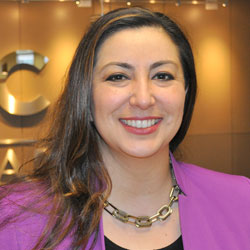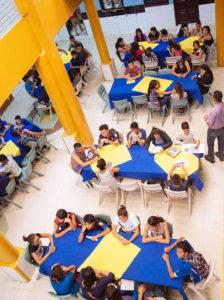Supporting juvenile justice and youth in Honduras
By Evelyn RupertMay 7, 2018
Approximately 540 Hondurans ages 12 to 18 are held in the country’s four juvenile detention centers. This year, the president and lawmakers are expected to weigh reforms to the juvenile justice system – including potentially lowering the age at which an accused person can be tried as an adult.

As the conversation around juvenile justice continues, the USAID Proponte Más program is advising the newly established National Institute for Attention to Youth Offenders, supporting organizations that serve youth exiting juvenile detention, and offering family counseling to high-risk youth. Proponte Más, a three-year program, is implemented by Creative Associates International.
Georgina McDowell, Creative Senior Associate and Project Director for Proponte Más, says that working with youth who have already come into conflict with the law brings its own challenges and calls for unique solutions.
McDowell will be speaking about her experience in the violence prevention field at the Gang Prevention and Intervention Conference May 7-8 in Los Angeles. In this Q&A, she shares some insights from Proponte Más and her work in juvenile justice and tertiary violence prevention.
How is Creative’s approach to violence prevention unique?
Georgina McDowell: We implement a Prevention and Intervention Family Systems Model, which basically means we acknowledge that young people do not generally live in isolation, but live in families, who are in the best position to create a positive and strong influence in the young person’s life. We also implement the Youth Services Eligibility Tool (YSET), which helps identify a youth’s level of risk in an evidence-based, scientifically sound manner.
Broadly stated, the YSET evaluates youth across nine risk factors: Those with one to three risk factors are considered at a primary risk level; four to six factors are secondary level; and seven to nine risk factors are considered tertiary.
Primary is the lowest level of risk; usually they have positive protective factors in their lives, an example being strong family cohesion. Those at a secondary level of risk are at the threshold of joining an illicit group, but have not yet engaged in behaviors that are consistently identified with, or in the interest of advancing the agenda of a group. Lastly, in the tertiary level, a young person is already in conflict with the law.
However, under Proponte Más, we have expanded the definition of tertiary to include young people who have been identified as having seven or more accumulated risk factors and also have self-reported delinquent behaviors that are associated with belonging to and/or in the interest of advancing the agenda of an illicit group.
Proponte Más works with youth ages 8 to 17 and their families in five municipalities across the country – Tegucigalpa, San Pedro Sula, La Ceiba, Tela and Choloma. To date, we have conducted the YSET with more than 6,500 youth in the five municipalities, and identified approximately 24 percent as being at the highest risk level.
How does diagnosing youth risk guide interventions?

McDowell: Youth at these different levels have different needs and circumstances that they face; therefore, interventions need to be tailored.
For example, someone in the primary level would most likely benefit from joining a soccer league because he or she is at a very low risk of joining an illicit group. But joining the same soccer league might be ineffective for someone at a tertiary level, who might instead benefit from going to a gang rehabilitation center.
It’s about addressing the risk factors and needs of the individual youth. How can we help them lower their risk levels, and if possible, assist with gang desistance?
What is unique about working with youth at a tertiary level? What are the challenges?
McDowell: I would say the two biggest challenges are lack of resources and services available to address youths’ specific needs and social stigma. Once a young person is tagged as a gang member, that follows them and robs them of opportunities of leading a positive, pro-social life.
For example, trying to get a job may be especially difficult if he or she is known in the community as having been in a gang and/or has tattoos that are normally associated with gangs. Sometimes even moving to another community proves insufficient when pursuing employment opportunities.
The general view in society is that once someone is in a gang, they will never get out, which doesn’t allow for a second chance for reintegration.
What is the role of juvenile justice in preventing violence?
Once a young person is tagged as a gang member, that follows them and robs them of opportunities of leading a positive, pro-social life.
Judges can also impose alternative measures instead of detention at sentencing. Essentially, alternative measures are court orders to appropriate programs and/or services as an alternative to being sentenced to serve time at a detention center. This gives youth a chance to learn vocational skills or receive much-needed services such as counseling, substance abuse and life skills, to name a few. A judge can dictate where a person goes to receive the most relevant resources or services for their specific situation.
How is Creative working to improve juvenile justice and tertiary violence prevention?
McDowell: One of the four key results of Proponte Más focuses squarely on juvenile justice, mostly through advancing and further incorporating alternative measures in the Honduran justice system.
Through Proponte Más’ work in the field, they have taking the lead in the formation of a Juvenile Justice Technical Committee, comprised of representative from diverse fields, including judges, government entities and other USAID implementers. This committee now serves as a type of advisory board for the National Institute for Attention to Youth Offenders.
We are also working with partners to create for the first time a Juvenile Justice Case Management System.
And, although Proponte Más is a secondary violence prevention program, when we identify someone as being at a tertiary level, we work with them and their families to reduce risk as part of a pilot program within the tertiary population.
Where do you think violence prevention programming needs to go from here?
McDowell: Programs must continue working with families and with multidisciplinary partners while considering the young person’s socioecological levels. I also think more should be done to identify and address areas of trauma, exposure to violence and the impact these have on young people’s brain and cognitive development. Additionally, more intentionality should be present around coordination for reintegration into communities after a juvenile has served time in a detention center.

